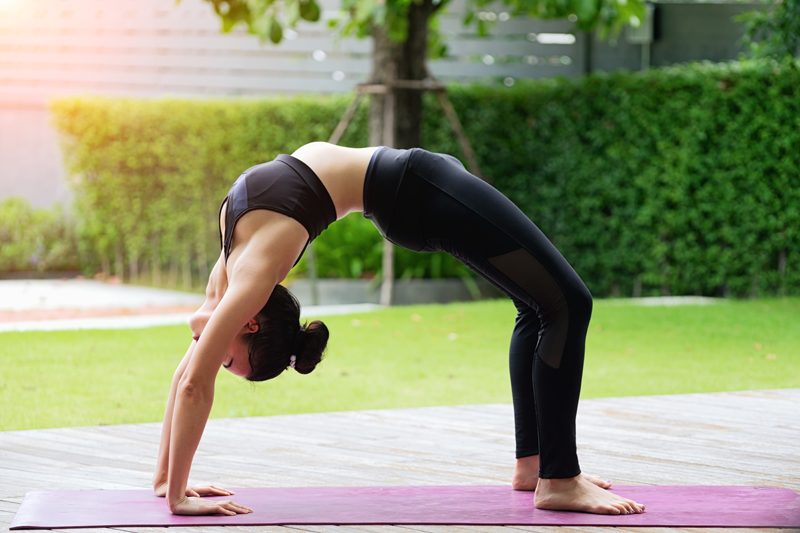
Yoga Poses that Emulate Animals
January 3, 2019
Yoga for Your Feet
January 17, 2019Yoga Poses for Hikers

If you’re a regular hiker, you’re probably no stranger to the tight calves, hamstrings, and quads that accompany the hobby. You may feel that pain is inevitable if you want to explore the great outdoors; however, that’s not necessarily the case! Yoga can be used to ease and prevent the soreness associated with hiking. In this article, we explore some of the best yoga poses for hikers. For best results, wear a lightweight yoga t-shirt to allow your muscles to breathe.
Seated Forward Fold
Seated forward bend stretches the back and calves. Additionally, the posture teaches you how to breathe in an uncomfortable position and relieves anxiety, headaches, and fatigue. To practice the asana, begin seated with your legs together and your hands by your sides. Lift your chest and lower your upper body towards your legs. Engage your abdominals and imagine your stomach moving toward your thighs. You are in Seated Forward Bend. If you can’t bend all the way, don’t worry! As long as you feel a stretch through your upper and lower back, the asana is doing its job.
Forward Fold
Forward Fold should be used after a long hike to stretch the hamstrings. To practice the asana, stand tall with your feet directly under your hips. Gently hinge at the waist and begin to lower your upper body towards the floor. To minimize pressure on the lower back, remember to bend your knees generously throughout the pose. Next, take hold of your ankles and let your body hang naturally toward the floor. You are in Forward Fold. Hold the posture for 30 seconds whilst breathing deeply. To increase the stretch, gently sway your torso or head from side to side.
Pigeon Pose
Pigeon Pose stretches the outer hip to relieve built-up tension. To practice the asana, stand tall on the mat with your feet together. Next, bend at the waist and lower your torso forward until you can touch your hands on the mat. Your body should now form a triangle. From this position, extend your right leg behind you. Bring your right knee to your right wrist and move your foot to touch your left wrist. At this state, your shin should be perpendicular to the front edge of your mat. You are in Pigeon Pose. Hold the asana for 30 seconds before switching sides.
Jiva Squats
Jiva Squats strengthens the glutes which help to stabilize the hips when walking. To practice the asana, begin standing tall with your feet hip-width apart. Next, bend forward until your hands are touching the mat. From this position, breathe in and lift your right leg up. On your exhale, step the leg forward into a lunge. Place your hands in front of your foot and push off your left foot to lift your right leg. On an inhale, extend both legs; as you breathe out bend both knees and tuck your left knee behind your right. You are in Jiva Squats. Repeat the process around 5 times before switching sides.
Staff Pose on Knees
Staff Pose is great for strengthening the quadriceps, inner thighs, and glutes. The posture can also improve your core stability and stamina – useful for those who enjoy long hikes. To practice the asana, begin on your knees. Place the tops of your feet on the mat and grip your hands together in front of your chest. Next, lean back whilst keeping your back as straight as possible. Your body should remain strong and engaged throughout this maneuverer. After a few seconds, take a deep breath in and slowly come back up. You are in Staff Pose. Repeat the process 5-10 times for best results.

Low Lunge
Your hip flexors work hard with every step you take. Low Lunge stretches out these overworked muscles to prevent tension and tightness. To practice the asana, begin standing tall. Lean your torso forward until your hands are touching the mat. From this position, lift your right leg up and bring it forward to your right hand. Lower your left leg to the ground. Finally, place both hands on your knee and shift your hips towards the floor. You are in Low Lunge. Hold the posture for 30 seconds before repeating on the opposite side.
Extended Side Angle
From Low Lunge, spin your back heel down onto the mat. Stretch both arms out to the sides and lift your chest upwards. As you exhale, move your front hand down to the outside edge of your front foot. If you require extra support, you can adapt this posture by placing your elbow on your thigh instead of putting your hand on the floor. Finally, reach your top arm out in front of you so your bicep is touching your ear. You are in Extended Side Angle. Hold the pose for 30 seconds before switching sides.
Legs Up The Wall
Turning your body upside down after a hike will reverse your blood flow and increase circulation. Additionally, Legs Up The Wall Pose is a great way to rest your hardworking legs! To practice the asana, place the shortest side of your yoga mat against a wall. When your mat is in place, sit down facing the wall. Gently lie back on the mat and extend both legs up the wall. Make sure that your bottom is almost touching the wall and that your legs are close together. You can either rest your hands on your stomach or on the mat – whichever feels most comfortable. You are in Legs Up The Wall Pose. Close your eyes and relax, holding the pose for around 5 minutes.
Half Plank Pose
Half Plank Pose strengthens the arms, legs, and core muscles. To practice the asana, come into a plank position. From here, stack your shoulders directly over your wrists and keep your arms and legs tucked into your body. Next, open your chest and draw your stomach in and up. Convert the posture to a Half Plank by lowering your knees for support. Finally, draw your tailbone in and up to engage the muscles around your pelvis. You are in Half Plank Pose. Hold the asana for as long as possible for best results.
In Summary
Using the postures above before and after your hike can help to reduce muscle soreness and tension. If you’re new to yoga, it’s worth attending a local class before practicing independently. This way, you can ensure you’re practicing each pose correctly and prevent unnecessary injury. If you’re strapped for time, try heading to the yoga studio straight from work. For ease of transport, pack your gear into a spacious yoga bag before you head off.

